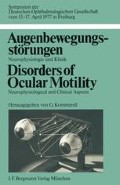Zusammenfassung
In Extrakten äußerer Augenmuskeln des Kaninchens (Mm. recti und obliqui) und des Menschen (M. obl. inf., ganzer Querschnitt oder makroskop. sagittal gespalten) wurden repräsentative Enzyme des energieliefernden Stoffwechsels gemessen. Ergebnisse: (1) Wie in den „roten” Skelettmuskeln ist beim Kaninchen der mitochondriale Anteil an der Energieproduktion in den äußeren Augenmuskeln hoch. (2) Die mitochondriale Kapazität des menschlichen M. obl. inf. scheint noch größer. (3) Der äußere Anteil des menschlichen M. obl. inf. hat größere Enzymaktivitäts-Gehalte als der bulbusnahe; das gilt besonders für die nichtglykolytischen Enzyme. Schlußfolgerungen: (1) Ähnlich dem „roten“Muskel ist der Energiestoffwechsel äußerer Augenmuskeln für Dauerbelastung ausgelegt. (2) Dies gilt besonders für die Orbitalen Anteile des menschlichen M. obl. inf.
Summary
Extracts prepared from extraocular muscles of rabbits (recti and obliques) and men (inferior oblique, full size or dissected in a sagittal plane) have been assayed for representative enzymes of energy supplying metabolism: (1) glycolysis — glyceraldehyde-3-phosphate-dehydrogenase (EC 1.2.1.12), lactic dehydrogenase (EC 1.1.1.27), (2) citric acid cycle/malic shuttle — isocitric dehydrogenase (NADP-specific/EC 1.1.1.42), malic dehydrogenase (EC 1.1.1.37), (3) pentose phosphate cycle — glucose-6-phosphate dehydrogenase (EC 1.1.1.49), (4) c-glycerophosphate shuttle — c-glycerophosphate dehydrogenase (EC 1.1.1.8). Results: (1) Similar to “red” skeletal muscles, the extraocular muscles of the rabbit seem to depend largely on mitochondrial energy production. (2) Mitochondrial capacity looks even bigger in human inferior obliques. (3) The outer (orbital) portions of human inferior obliques show higher levels of enzyme activity than the inner (global) layers; this affects especially the non-glycolytic enzymes. Conclusions: (1) Similar to “red” muscle, patterns of enzyme activity of extraocular muscles are shaped to manage continuous action. (2) Even with rather crude separation this seems especially valid for the orbital layers of human inferior obliques.
Access this chapter
Tax calculation will be finalised at checkout
Purchases are for personal use only
Preview
Unable to display preview. Download preview PDF.
Literatur
Alvarado, J. A., van Horn, C.: Muscle cell types of the cat inferior oblique. In: Basic mechanisms of ocular motility and their clinical implications. Lennerstrand, G., Bach-y-Rita, P. (eds.), p. 15. Oxford: Perga-mon Press 1975
Asmussen, G., Kiessling, A., Wohlrab, F.: Histochemische Charakterisierung der verschiedenen Augenmuskelfasertypen in den äußeren Augenmuskeln von Säugetieren. Acta anat. (Basel) 79, 526 (1971)
Bücher, T., Klingenberg, M.: Wege des Wasserstoffs in der lebendigen Organisation. Angew. Chemie 70, 552 (1958)
Bücher, T., Luh, W., Pette, D.: Einfache und zusammengesetzte optische Tests mit Pyridinnukleotiden. In Hoppe-Seyler und Thierfelder: Handbuch der physiologisch- und pathologisch-chemischen Analyse, Bd. 6 A, S. 292, 10. Aufl. Berlin, Göttingen, Heidelberg, New York: Springer-Verlag 1964
Bücher, T., Rüßmann, W.: Gleichgewicht und Ungleichgewicht im System der Glykolyse. Angew. Chemie 75, 881 (1963)
Burke, R. E., Levine, D. N., Tsairis, P., Zajac, F. E.: Physiological types and histochemical profiles in motor units of the cat gastrocnemius. J. Physiol. 234, 723 (1973)
Collins, C. C: The human oculomotor control system. In: Basic mechanisms of ocular motility and their clinical implications. Lennerstrand, G., Bach-y-Rita, P. (eds.), p. 145. Oxford: Pergamon Press 1975
Harker, D. W.: The structure and innervation of sheep superior rectus and levator palpebrae extraocular muscles. I. Extrafusal fibers. Invest. Ophthal. 11, 956 (1972)
Hess, A.: The structure of slow and fast extrafusal muscle fibers in the extraocular muscles and their nerve endings in guinea pigs. J. Cell. Comp. Physiol. 58, 63 (1961)
Kugelberg, E.: Histochemical composition, contraction speed, and fatiguibility of rat soleus motor units. J. Neurol. Sci. 20, 177 (1973)
Kugelberg, E.: The motor unit: histochemical and functional correlations. In: Basic mechanisms of ocular motility and their clinical implications. Lennerstrand, G., Bach-y-Rita, P. (eds.), p. 85. Oxford: Pergamon Press 1975
Lehninger, A. L.: Biochemie. Weinheim: Verlag Chemie 1975
Lowry, O. H., Passoneau, J. V.: Some recent refinements of quantitative histochemical analysis. In: Recent advances in quantitative histo- and cytochemistry — Methods and applications. Dubach, U. C., Schmidt, U. (Hrsg.), p. 63. Bern, Stuttgart, Wien: Hans Huber Publishers 1971
Mayr, R.: Structure and distribution of fiber types in the external eye muscles of rat. Tissue Cell 3, 433 (1971)
Miller, J.: Cellular organization of rhesus extraocular muscle. Invest. Ophthal. 6, 18 (1967)
Peachey, L.: The structure of the extraocular muscle fibers of mammals. In: The control of eye movements. Bach-y-Rita, P., Collins, C., Hyde, J. (eds.), p. 45. London, New York: Academic Press 1971
Pette, D.: Plan und Muster im zellulären Stoffwechsel. Naturwissenschaften 52, 597 (1965)
Pette, D., Bücher, T.: Proportionskonstante Gruppen in Beziehung zur Differenzierung der Aktivitätsmuster von Skelettmuskeln des Kaninchens. Hoppe-Seylers Z. physiol. Chem. 331, 180 (1963)
Rüßmann, W., Heisig, B.: Analogy and difference in ciliary process enzyme systems. Ophthal. Res. 3, 215 (1972)
Author information
Authors and Affiliations
Editor information
Editors and Affiliations
Rights and permissions
Copyright information
© 1978 J. F. Bergmann Verlag, München
About this paper
Cite this paper
Rüßmann, W., Schäfer, E., Schrick, C. (1978). Zur Organisation des Energiestoffwechsels äußerer Augenmuskeln. In: Kommerell, G. (eds) Augenbewegungsstörungen / Disorders of Ocular Motility. Symposien der Deutschen Ophthalmologischen Gesellschaft. J.F. Bergmann-Verlag. https://doi.org/10.1007/978-3-642-48446-9_3
Download citation
DOI: https://doi.org/10.1007/978-3-642-48446-9_3
Publisher Name: J.F. Bergmann-Verlag
Print ISBN: 978-3-8070-0303-0
Online ISBN: 978-3-642-48446-9
eBook Packages: Springer Book Archive

